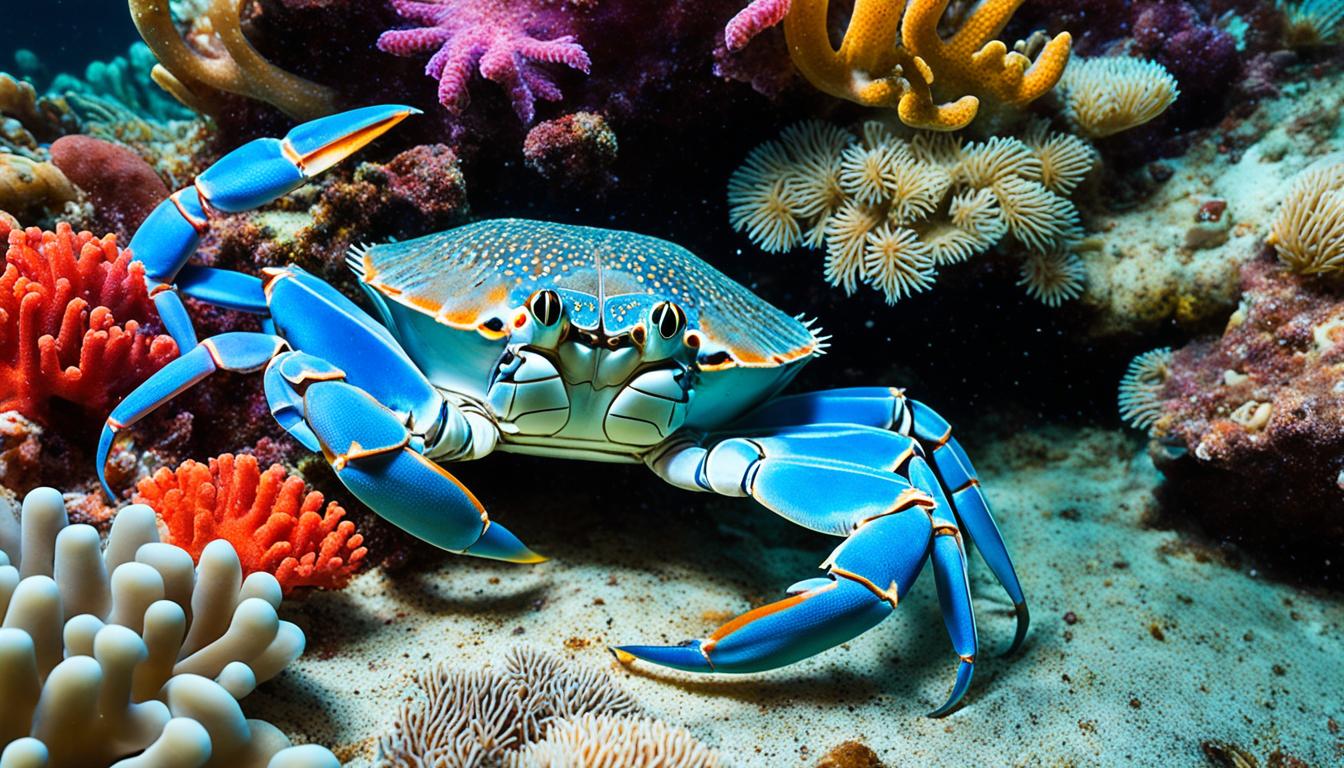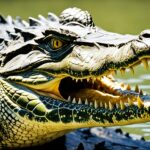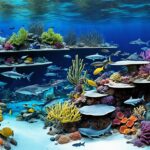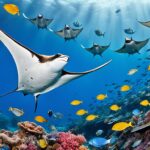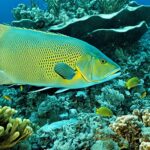Crabs are key players in the ocean, influencing the balance of their habitats. You might ask, how do they connect with other sea creatures? They interact in many ways, from hunting to forming alliances. These interactions are crucial for the ocean’s health and stability. By looking into these relationships, we learn more about the complex life of the sea and the vital part crabs play.
Understanding Crab Behavior in Marine Ecosystems
Crabs are fascinating creatures that play a big role in marine ecosystems. They help keep the food web balanced by being both predators and prey. By controlling the numbers of other organisms, crabs help keep the ecosystem diverse.
Crabs as Key Players in the Food Web
Crabs eat a wide variety of foods, like algae, plankton, and small fish. This helps shape the marine life around them. By understanding how crabs interact with other sea creatures, we see their role in nutrient cycling and energy flow in their homes.
Adaptations for Survival in Various Habitats
Crabs have many ways to survive in different ocean environments. For example:
- Lined shore crabs can change color to hide in rocky areas.
- Mole crabs dig tunnels in sandy beaches to live.
- Some species change their behavior with the tides to find food better.
These strategies help them avoid predators and survive tough conditions. The complex ways crabs adapt show how crucial they are to the ocean’s balance.
| Crab Species | Habitat | Feeding Behavior | Key Adaptations |
|---|---|---|---|
| Lined Shore Crab | Rocky shores | Omnivorous | Camouflage |
| Mole Crab | Sandy beaches | Filter feeder | Burrowing skills |
| Blue Crab | Estuaries | Predatory | Strong claws for catching prey |
How do crabs interact with other marine life?
Crabs play a big role in marine ecosystems as both hunters and hunted. They help keep the balance and diversity of their homes. Their actions are key to the health of the marine food web and affect many species, including themselves.
Predator-Prey Relationships
Crabs have complex relationships with other sea creatures. For example, blue crabs are top predators in places like the Chesapeake Bay. They eat many things, like clams and small crabs. This helps control the number of their food sources.
These predator-prey ties are vital for keeping marine ecosystems stable.
Crabs as Both Predators and Prey
Crabs are not just hunters; they can also be hunted by bigger sea animals. To survive, they need to avoid being eaten. Some crabs, like the mole crab, dig into sand to hide from predators. This helps them live longer and adds to their habitat’s complexity.
| Crab Species | Role | Common Prey | Common Predators |
|---|---|---|---|
| Blue Crab | Predator | Bivalves, Small Crustaceans | Larger Fish, Birds |
| Mole Crab | Predator | Plankton | Fish, Sea Birds |
| Fiddler Crab | Prey | Detritus, Algae | Raccoons, Herons |
These examples show how crabs play a big part in their ecosystems. They highlight the balance of life in their environments.
Symbiotic Relationships Involving Crabs
Crabs often form interesting symbiotic relationships in marine ecosystems. These relationships help both parties survive and improve their habitats’ health and dynamics.
Examples of Mutualism Among Crustaceans
Crabs and some fish species have a mutualistic relationship. Crabs live in the fish’s territory for safety, while the fish gets protection from predators. This shows how crabs and fish can help each other, keeping the ocean balanced.
Crab and Urchin Partnerships
Crabs and sea urchins work together too. Crabs use the urchins’ spines for defense against predators. Sea urchins get to move around more and find food easier with crabs. This partnership makes both species more resilient in changing environments.

Crab Communication with Other Sea Creatures
Crabs play a big role in their underwater world by communicating with each other. They use body language and sounds to send messages. This helps us understand their social life and how they behave.
Body Language and Visual Signals
Crabs use body language to talk to each other. They show different postures and movements to share information. For example, they raise their claws to show they’re in charge or to mark their territory.
They also have special moves for mating, trying to catch someone’s eye. These visual signals help crabs talk without making a sound. It shows how they can adapt in different places.
Sound Production Among Crabs
Some crabs make sounds to communicate. They do this by moving their bodies or claws. These sounds can mean different things, like calling for a mate or warning others of danger.
This way of communicating adds to the complex social life of crabs in the water.
Crabs and Marine Life Interactions in Coastal Habitats
In coastal habitats, crabs are key players, especially in estuaries. These areas are crucial for young crabs and many marine species. They offer plenty of food and shelter, helping young creatures grow and survive.
Importance of Estuaries as Nursery Grounds
Estuaries are perfect for young marine life, including crabs. They are full of nutrients that help young organisms grow. Seeing crabs in estuaries shows that these places are healthy and support many marine species.
Crabs’ Role in Habitat Maintenance
Crabs help keep coastal habitats healthy. By digging burrows, they improve water flow and make nutrients available. They also eat detritus, which helps cycle nutrients and supports biodiversity. Keeping crabs healthy is key to a thriving coastal ecosystem.
FAQ
How do crabs interact with other marine life?
Crabs interact with other sea creatures in many ways. They eat small fish and algae, helping to keep the ocean balanced. They also become food for bigger animals.
What are some examples of crab behavior with marine life?
Crabs hide in rock crevices to avoid predators. They use body language and signals to talk to each other. They even work with sea urchins in mutualistic partnerships.
Can you explain predator-prey relationships involving crabs?
Crabs are important in the ocean as both hunters and the hunted. For example, blue crabs eat bivalves but are eaten by bigger fish and birds. This balance is key to the ocean’s ecosystem.
What are symbiotic relationships involving crabs?
Crabs often work with other sea creatures, like sea urchins. They protect each other and share food. These partnerships show how different species depend on each other in the ocean.
How do crabs communicate with other sea creatures?
Crabs use body language and visual signals to talk. They show off their claws and posture to warn others or find a mate. Some even make sounds to signal danger or during courtship.
Why are estuaries important for crabs and marine life interactions?
Estuaries are vital for young crabs and other sea life. They offer food and shelter, helping them grow. Crabs help keep estuaries healthy by bringing in air and nutrients.
What adaptations do crabs have for survival in various habitats?
Crabs have special ways to dig burrows and blend in with their surroundings. These skills help them survive in different parts of the ocean.

